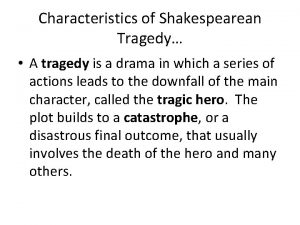Othello An Introduction Othello A Shakespearean Tragedy l








- Slides: 8

“Othello” An Introduction

“Othello” – A Shakespearean Tragedy l l “Othello” is a Shakespearean Tragedy It encompasses elements of tragedies such as: It ends with the death of numerous characters including the title character l It encompasses historical and military details l The protagonist is admirable, but flawed, with the audience able to understand sympathise with the character. l The protagonist is capable of both good and evil l Free will is insisted upon – the protagonist must always be able to back out of a situation or to redeem themselves – but always towards their inevitable doom. l

The Plot The plot for Othello was developed from a story in Cinthio's collection, the Hecatommithi, which it follows closely. The only named character in Cinthio's story is "Disdemona", which means "unfortunate" in Greek; the other characters are identified only as "the standardbearer", "the captain", and "the Moor". The first known performance of the play occurred on November 1 st 1604 at Whitehall Palace in London.

Othello – a moor Othello is described in the play as a moor, and a general in the Venetian Army. The origin of the word “moor” comes from the word “mauri” which was used to describe a group of people called the Berbers, who came from North Africa.

What does it mean to be Moorish? Moors were characterised in Elizabethan England as being alternately or simultaneously noble or monstrous, civil or savage. l It was often the case (in literature) that a moor was presented as someone accepted by society to a certain point, but then rejected due to other factors. l

Iago is one of Shakespeare’s most sinister villains, often considered so because of the unique trust Othello puts in him, which he betrays while maintaining his reputation of honesty and dedication. l Shakespeare contrasts Iago with Othello’s nobility and integrity. l Iago is a malcontent – he has a bitter and cyncial view of the world around him. l The name Iago is a shortened version of the Spanish name “Santiago” or “St James”. l Saint James of Spain was also known as “St James the Moor Killer” which seems appropriate within the play. l

The Cuckold Any man whose wife cheated on him (without his knowledge) was known as a cuckold. The word derives from “cuckoo” – the bird known for laying their eggs in another’s nest. It was highly undesirable to be considered a cuckold. All of the community would find out about it and it was considered a public humiliation. Cuckolds were often described as having horns – a hangover from the days when a cuckold was forced to parade around his town wearing antlers as a sign of his wife’s infidelity.

Jealousy was viewed as something irrational and linked to the deadly sin of envy. l It was viewed as a sudden infection against which there was no prevention or cure. l It was thought of as eroding trust and it dissolved the bonds holding together marriages, families and social frameworks. l Being jealous could let in evil and chaos and it was a state greatly feared by Shakespeare’s audiences. l















